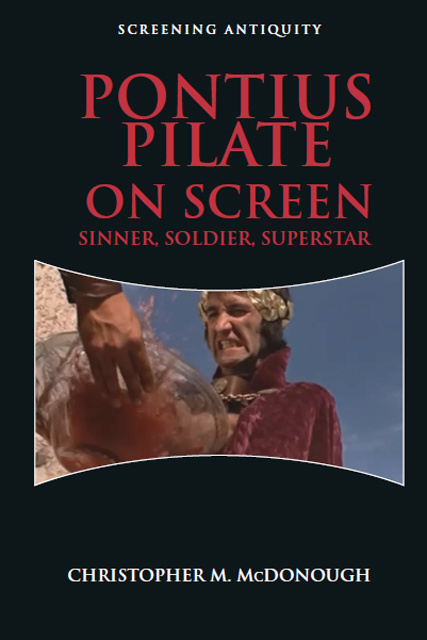Book contents
- Frontmatter
- Contents
- List of Figures
- Acknowledgements
- Series Editors’ Preface
- Frontispiece
- Prologue: ‘Do You Enjoy Being a Symbol, Pontius?’ The Trial of Pontius Pilate and Governor Collins
- 1 Quod Scripsi Scripsi
- 2 The Silent Pilate
- 3 The Roman in the Living Room: Pilate on TV in the Early 1950s
- 4 Mrs Pilate: Claudia Procula and Clare Boothe Luce
- 5 Pilate in CinemaScope, or Notes on Roman Camp
- 6 Finding Meaning in the Middlebrow: Pilate in the 1960s
- 7 What Is Truth? Pilate as 1970s Moral Relativist
- 8 Michael Palin’s Accent in Monty Python’s Life of Brian, and a Few Others
- 9 Grand and Not-So-Grand Inquisitors of the Reagan Age
- 10 ‘We at War’: Pilate for the New Millennium
- Epilogue: A Time of Handwashing
- Works Cited
- Index
3 - The Roman in the Living Room: Pilate on TV in the Early 1950s
Published online by Cambridge University Press: 03 June 2023
- Frontmatter
- Contents
- List of Figures
- Acknowledgements
- Series Editors’ Preface
- Frontispiece
- Prologue: ‘Do You Enjoy Being a Symbol, Pontius?’ The Trial of Pontius Pilate and Governor Collins
- 1 Quod Scripsi Scripsi
- 2 The Silent Pilate
- 3 The Roman in the Living Room: Pilate on TV in the Early 1950s
- 4 Mrs Pilate: Claudia Procula and Clare Boothe Luce
- 5 Pilate in CinemaScope, or Notes on Roman Camp
- 6 Finding Meaning in the Middlebrow: Pilate in the 1960s
- 7 What Is Truth? Pilate as 1970s Moral Relativist
- 8 Michael Palin’s Accent in Monty Python’s Life of Brian, and a Few Others
- 9 Grand and Not-So-Grand Inquisitors of the Reagan Age
- 10 ‘We at War’: Pilate for the New Millennium
- Epilogue: A Time of Handwashing
- Works Cited
- Index
Summary
Christ is one of the ‘family’ now. I often wonder if God recognizes His own son the way we’ve dressed him up, or is it dressed him down? He’s a regular peppermint stick now, all sugar-crystal and saccharine when he isn’t making veiled references to certain commercial products that every worshipper absolutely needs.
– Ray Bradbury, Fahrenheit 451 (1953)It was on the small screen of the television set rather than the big screen of the cinema that the most significant dramatisations of Pontius Pilate would next appear in the twentieth century. The success of DeMille’s 1927 blockbuster King of Kings had precluded the production of another big-budget offering on the topic until Nicholas Ray’s 1961 remake, although a listless 16mm colour version of a stage drama, The Pilgrimage Play, written by Pittsburgh heiress Christine Wetherill Stevenson, would be released for church screenings in 1949. With the end of the Depression and the victorious conclusion of the Second World War, the circumstances of life for many in America had changed, as had their modes of leisure-time activity. Whereas, at one time, an evening of on-screen entertainment had meant a trip to the movie theatre, most living rooms in Middle America now possessed a TV set. Hollywood continued to turn out pricey epic films on the Old Testament and other ancient topics through the 1930s and 1940s, but it was through the new medium of television that the New Testament would come to the masses in the post-war period. Just as in the early days of cinema Reverend Herbert Jump and others had urged fellow clergy to embrace film as a tool for religious use, so when the new medium first began to emerge, a similar movement arose to make and distribute works about the Gospels for the small screen. By and large, the shows that found their way onto the airwaves in TV’s early years for the at-home, family-centred Christian market were made with low budgets and high aims. Equally high-minded and better-funded network programming would likewise turn to the story of Pilate in the 1950s, as was seen in the discussion of Robert Sherwood’s The Trial of Pontius Pilate in the Prologue.
- Type
- Chapter
- Information
- Pontius Pilate on ScreenSinner, Soldier, Superstar, pp. 44 - 64Publisher: Edinburgh University PressPrint publication year: 2022



